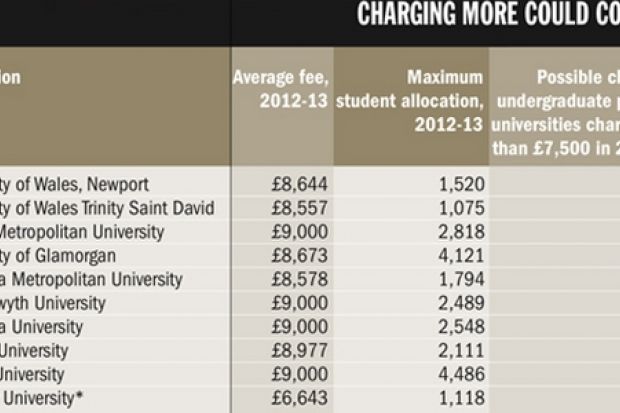Welsh universities are facing cuts in their student numbers of up to 58 per cent unless they lower their tuition fees after the principality's funding council announced a radical version of the English "core-and-margin" model.
In what has been described as a "terrifically centralist" policy and a "dry run" for what could eventually be rolled out in England, more than a quarter of Welsh undergraduate places will be allocated to institutions that charge fees of under £7,500.
From 2013-14, 53 per cent of Welsh student places in non-priority subjects will be removed from "general allocations" to create a "margin", under the plans outlined this week by the Higher Education Funding Council for Wales.
Of these margin places, half will be reallocated to lower-priced institutions, while the other half will be distributed on the basis of Welsh government priorities: universities' research income, total income, overseas students cohort and number of spin-off companies.
In contrast, the margin distributed to sub-£7,500 institutions in England will constitute just 8 per cent of places, although the plan is to increase this proportion over time.
In its briefing on the plans, HEFCW revealed how many student places would be distributed to different institutions on the basis of the government's priorities.
All universities except Cardiff University, which performs well against the set criteria, could suffer cuts of more than 9 per cent unless they are able to secure places from the pool reserved for cheaper institutions (see table, below).
Only Glyndwr University has set its fees below £7,500.
'Dry run' for England?
Paul Temple, reader in higher education management at the Institute of Education, University of London, said most Welsh universities would not be able to avoid lowering their fees.
"It's terrifically centralist," he said of the policy. "It does leave very little scope for institutional decision-making."
Dr Temple argued that the policy was illustrative of the way that efforts to introduce market forces to higher education usually ended with governments dictating funding levels and allocating places.
"It's a dry run for core and margin in England. This could be a kind of model...particularly if English institutions don't reduce their fees to the level that [the Department for Business, Innovation and Skills] calculated," he said.
Philip Gummett, chief executive of HEFCW, said that the council was attempting to drive down average fees to remain competitive with England - and to make sure there was money left to incentivise other priorities.
The Welsh government will pay the tuition fees of all students domiciled in Wales above a threshold of £3,465.
If no Welsh universities reduced their fees, Glyndwr would not receive all the remaining places because HEFCW has capped the number of margin places any university can win back at 130 per cent of the places removed to create the margin.
In such a scenario, the remaining places would be redistributed among the other universities, regardless of their fee levels.
However, each university is vulnerable to cuts if rival institutions do drop their fees.
In another scenario, if all universities except Cardiff reduced their fees to below £7,500 a year, they would be allocated margin places depending on their share of priority subjects.
Analysis shows that in this scenario, Bangor and Swansea universities would see their allocations increase by the maximum allowed by the margin cap.
Michael Scott, vice-chancellor of Glyndwr, said the new system had "in a sense" vindicated his institution's decision to charge lower fees than all the other universities in Wales.
david.matthews@tsleducation.com.
19 January update:
HEFCW announced today that Professor Gummett would be retiring as chief executive later this year, with a likely leaving date of between July and October. He joined the funding council in 2000 and became chief executive four years later.
